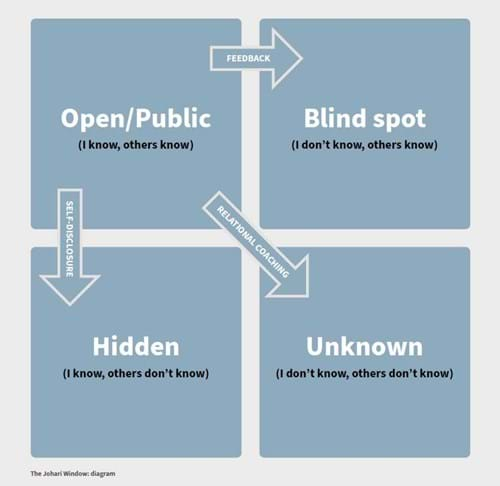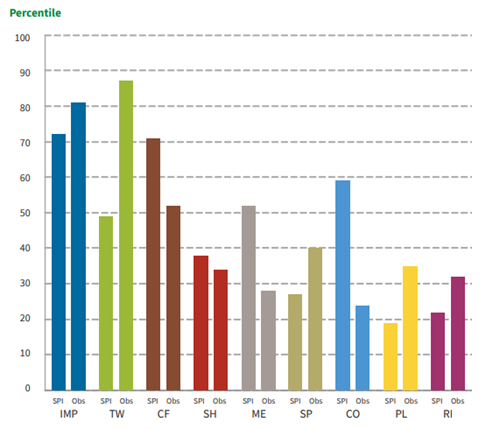Understanding the Johari Window model
How do I identify my strengths and weaknesses? How do I see myself as others see me?
The Johari window was developed by Joseph Luft and Harry Ingham in the 1950s. It’s a simple tool which helps us to visualise how we see ourselves, how others see us, and how well we articulate ourselves to those around us.
The model increases self-awareness and improves communication and interpersonal relationships. In addition, it can help improve team dynamics and build high-performing teams. Here we’ll provide a definition, example and template for using the Johari Window and Belbin Team Role models in conjunction.

The Johari Window: diagram
The Johari Window consists of four quadrants.
- The first, open area concerns public information that is known to ourselves and others.
- The hidden area is that which is known to the individual but not to others. When we disclose personal information or articulate how we like to work, this is known as ‘self-disclosure’.
- The third quadrant is the blind area – that which is known to others but not to ourselves. We need feedback from those around us in order to access this information.
- The last quadrant is the unknown area – information which is not yet available to ourselves or to others. This can sometimes be accessed by relational coaching.
The tenets of the Johari methodology are that we build trust through self-disclosure and learn through feedback.
Understanding ourselves
We know that people who work to their strengths outperform those who don’t. According to Belbin Team Role theory, there are nine Team Roles – nine distinct ways of contributing in a team and relating to others. Each person has a number of Team Role strengths – roles that come naturally to them. When we play to these strengths, we are more likely to be engaged and fulfilled in our work. If you are new to BELBIN and want to know more about the 9 Team Role behaviors, watch a 2 Minute fun film here.
A Belbin Individual report (generated after you complete the Belbin questionnaire) quickly identifies your key strengths in terms of these nine Team Roles and suggests working styles that may best suit you. It offers personalised advice and guidance on how to articulate these strengths to others.
Checking our blind spot
The next step is to ask colleagues for feedback. Whilst this sounds fine in theory, people are often afraid to seek feedback. Traditional 360 feedback might be tied to performance grades or have become polluted by office politics.
Even if this is not the case, asking for feedback often means relinquishing some control. We don’t know if others will be constructive or fair. We might discover things about ourselves or others’ perceptions that we don’t like.
Safety is an important factor in providing and receiving authentic feedback, and in learning from our discoveries. Likewise, it can be easier for colleagues to be honest if giving feedback in a structured survey form, rather than face to face. This gives both parties time for reflection.
Whilst many psychological tests analyse personality and rely on self-reporting, Belbin measures behaviour. Since behaviour is observable, others can complete an Observer Assessment to provide constructive feedback, framed in terms of Belbin Team Role contributions. We recommend that you choose Observers who have worked closely with you for at least six months, and preferably in the same team context.
Where do your Belbin strengths sit in the Johari Window?
Your Belbin Individual report is updated once you reach four or more Observers, and you can see at a glance whether others see your strengths as you do, or where the differences may lie.
Where your understanding of your Team Roles aligns with others’, you’re working in the ‘open’ or ‘public’ quadrant. Where there are differences, these may fall into the blind spot or hidden areas of the Johari Window.
Observer feedback can throw up some surprises. We might not agree with everything that comes up, but it is important to acknowledge and address the findings, since they clearly have an impact on how others perceive us, especially where there is consensus between Observers.

Image: Comparing Self (SPI) and Observer (Obs) perceptions of Team Role strengths - taken from the Belbin Individual report
Using Belbin and Johari Window - an example
In this example, the individual in question is a strong Implementer-Teamworker, with a least preferred role of Resource Investigator.
Observers see much higher Teamworker behaviours than does the individual themselves. This could indicate a blind spot – that the person in question has latent strengths which aren’t being used to full potential.
The individual sees more Completer Finisher, Co-ordinator and Monitor Evaluator behaviours than Observers do. This could indicate hidden attributes that others have not yet witnessed, because the person hasn’t had an opportunity to play those particular roles in their job.
Once you’ve identified the Team Roles in the blind spot and hidden areas, you can begin to formulate a strategy, using examples from your work, to announce your strengths to others. This might mean that you are given more of the sorts of work you enjoy doing, increasing your engagement and honing those skills further.
Using BELBIN in conjunction with the Johari Window Model serves to transform the effectiveness of Personal Development and Team Building initiatives, in Organizations. Whether in Team Coaching, Executive Coaching, or in Leadership Development, the BELBIN Team Roles Methodology can accelerate and enhance the width and depth of the development agenda, as seen above!
You can find out more about the full suite of Belbin Reports here.
If you are new to BELBIN and want to know more about the 9 Team Role behaviors, watch a 2 Minute fun film here.
Next Steps
1. Find out Belbin behavioural strengths and weaknesses, for yourself and for all in your Team, by getting a BELBIN Individual Report done for each. Are there any blind or hidden areas? What can you do to minimise them?
2. Contact us to understand how you can use Belbin Team Roles to help you and your Team with feedback and disclosure, that help grow your arena - Open / Public Quadrant, towards being much more effective as an individual and as a team member.
3. How about exploring getting BELBIN Accredited? Ask for an obligation free conversation with our experts to know how a BELBIN Accreditation can help you be an even better People Pro!
Looking for more insights on transforming performance of people and teams? Why not check out our article on Belbin and EQ , Belbin and GroupThink, or Belbin and Lencioni’s Five Dysfunctions of a Team?
This insight document is adapted with permission from www.belbin.com



